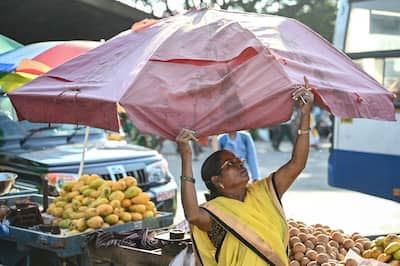Vast swaths of Asia are suffering from a record-breaking heat wave, from the Philippines to Myanmar, forcing millions of children to stay indoors.
• Read also: Indonesia: A new eruption of Mount Ruang volcano and the closure of a nearby international airport
• Read also: Burma: A new temperature record was set in April at 48.2°C
• Read also: The Philippines is suffocating after temperatures rise in Manila
What are the affected areas?
The heat is hitting most regions of South and Southeast Asia, with record temperatures recorded in recent days in Chuuk in Burma and Manila, the capital of the Philippines.
Thai authorities warned of “severe” weather conditions, while temperatures in Cambodia, Myanmar, Vietnam, India and Bangladesh were expected to exceed 40 degrees.
Even northern Japan was affected, with temperatures exceeding 25 degrees in Sapporo, something unheard of for this time of year.
What causes this heat?
The months leading up to the monsoon or rainy season are usually warm, but this year temperatures are well above average in many countries. Experts say climate change is causing heat waves to be more frequent, more intense and longer.
Asia is also seeing temperatures rise faster than the global average, according to the World Meteorological Organization, a United Nations agency.
Milton Spear, a meteorologist and researcher at the University of Technology in Sydney, told AFP that the El Niño weather phenomenon is playing a role this year.
“The absence of clouds in El Niño means that temperatures are likely to be higher on average,” he says. As for the sea surface, temperatures are currently several degrees higher than normal, “which contributes to keeping them higher than average inland during the night” and thus seeing them “rising from a higher base” during the day.
Other factors also play a role, such as deforestation, which reduces shade and increases dry surface area, and urbanization, where concrete, glass, and steel structures absorb heat rather than reflect it.
Who are the affected populations?
Extreme heat particularly affects children, the elderly, and people with pre-existing diseases or disabilities. Those living in poverty often lack cooling solutions at home, or are forced to work in conditions that do not provide adequate thermal protection.
UNICEF has warned that 243 million children in the Pacific and East Asia region are at risk of heatwaves.
“Children’s exposure to heat waves leads to heat stress,” explains Salwa Al-Eryani, a health specialist at UNICEF’s regional office.
“Serious problems can develop, such as cardiovascular disease, organ failure, and muscle and nerve dysfunction,” she told AFP.
How are countries responding?
The authorities in many countries asked their citizens to stay in their homes. In Nepal, hospitals were put on alert, while Cambodian authorities urged public schools to keep doors and windows open for ventilation.
Bangladesh and the Philippines went further, deciding to close schools for several days. But in the absence of air conditioning or suitable buildings, many children, who are forced to stay at home, do not benefit from the cool temperatures in homes, Ms. Al-Eryani warned.
till when?
In Bangladesh, the heat is not expected to subside until Thursday at the earliest. In Thailand, meteorologists have warned that annual rains may not fall until late May, several weeks later than usual.
Even when the monsoon arrives, the overall warming trend will continue, Milton Speer predicts.
“Heat waves will continue to occur more frequently because the oceans and atmosphere are gradually warming due to global warming,” he says, posing risks to crops and livestock, as well as humans working outside.
Adaptation will be key, Mr Speer said, including providing “sustainable neighborhood buildings with air conditioning, where people can go during the day and sleep at night”.

“Total coffee aficionado. Travel buff. Music ninja. Bacon nerd. Beeraholic.”








More Stories
Fluoroscopy | “Self-coup”?
This is why you find it difficult to wake up in the morning.
She meets her boss at the airport after taking sick leave.